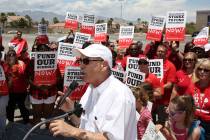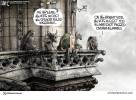Stadium plan: Authority board best chance to get it done
Southern Nevada needs a new stadium in close proximity to the Strip. Such a project would provide a major economic boost, allowing the region to attract new special events while giving existing ones room to grow. Open-air Sam Boyd Stadium is too old and too far from the resort corridor — and too vulnerable to the elements — to appeal to touring acts and some sporting events.
Everyone associated with the valley’s tourist trade has known this for years. Yet here we are, a day away from the end of another legislative session, no closer to agreement on a viable plan to build such a facility.
There has been no shortage of stadium plans. The latest attempt, announced Tuesday, came from Majestic Realty, which proposed a 50-50 partnership with the state to build a stadium between the Strip and the University of Nevada, Las Vegas campus. This after Majestic was dumped by the university a couple of months back as a partner for a proposed “mega events center” that would be located on campus.
Majestic, with point man Craig Cavileer of the Silverton backed by California billionaire developer Ed Roski, has committed $385 million toward a projected $770 million cost. Majestic deserves a lot of credit for continuing to pursue this project — and especially for its willingness to front almost $400 million. The company had pledged nearly identical support to UNLV for the campus project before the plan fell apart at the start of the 2013 Legislature because of a lack of support from the gaming industry.
But Majestic’s new push — which comes as UNLV reboots its stadium plan — came far too late in the legislative session to have any chance at passage. Lawmakers have not had enough time to properly review this project, as Assembly members noted Wednesday, and far too many questions are unanswered — not just for Majestic’s last-minute bid, but for all the stadium proposals that have come down the pike the past few years.
The biggest question for any group seeking a public-private partnership: What’s the public’s stake once the project is completed? It would be far preferable for such a project to be funded solely with private money. But if that were possible, the stadium would have been completed years ago. If public dollars are to be used, taxpayers must have a stake in the returns.
Then there’s the question of how to come up with all that tax money. Majestic’s proposed $1.50-per-trip taxi tax was ill-considered. Singling out a single industry and further soaking visitors to build a stadium is terrible policy.
And, as Majestic and UNLV learned, no project will move forward without the support and involvement of the Strip’s gaming giants. If we’re ever to get a shovel in the ground for a new stadium, any proposal must be complete well ahead of the start of a legislative session.
Assembly Bill 335, still alive in Carson City as this section went to press, is the best plan to accomplish that. The bill would create an 11-member UNLV stadium authority board, including two representatives of the resort industry, and require it to complete a specific proposal by Sept. 30, 2014, for consideration by the 2015 Legislature.
There’s no guarantee a transparent authority board can reach an agreement that will please gaming, university and taxpayer interests, then win legislative support. But it’s certainly worth trying. The Legislature should pass AB335.























